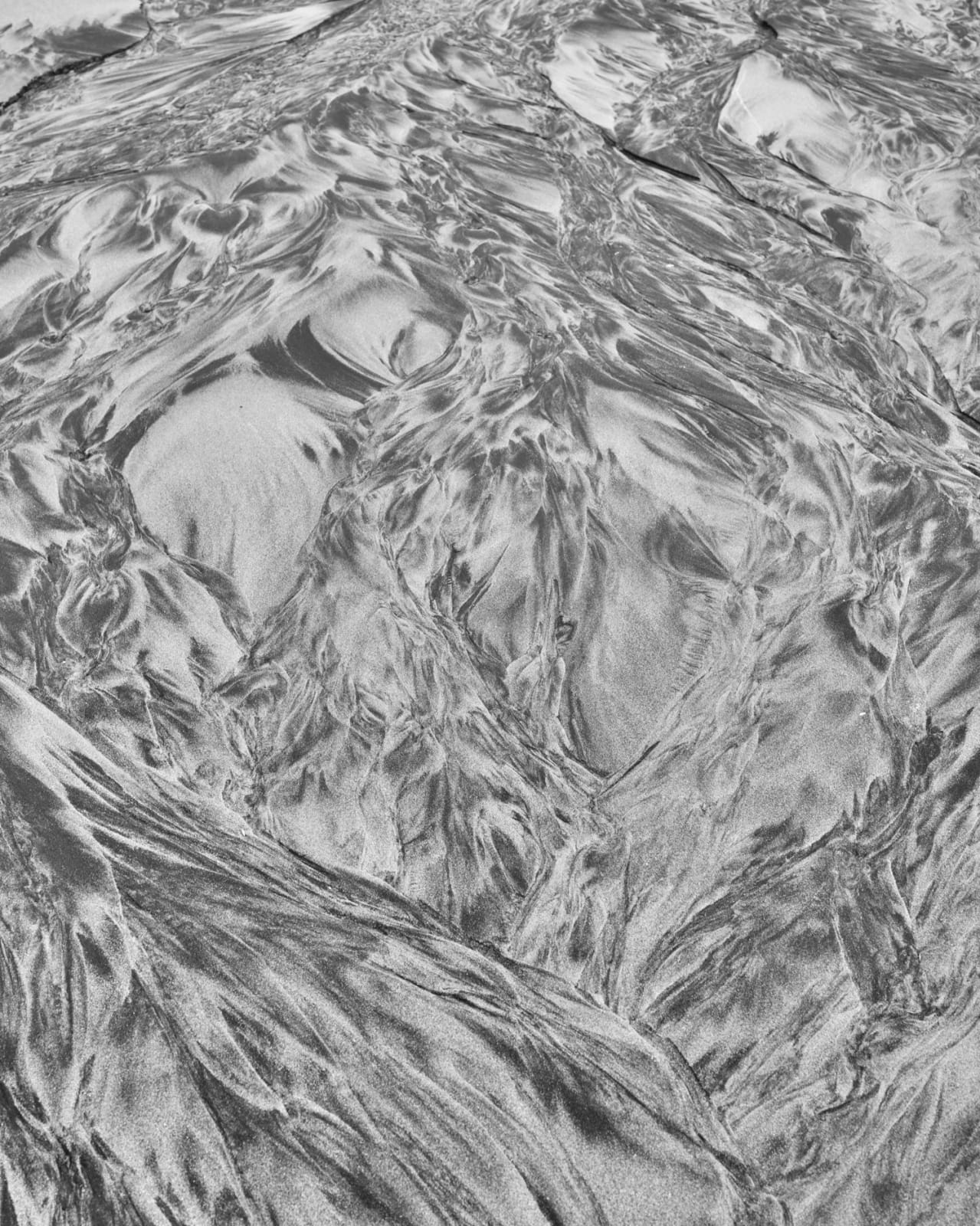Ana Zibelnik
Brez naslova II / Untitled II, 2021
arhivski pigmentni tisk na baritni Hahnemühle papir / archival pigment print on Hahnemühle baryta
31 x 25 cm
edicija 7 + 2 AP / edition of 7 + 2 AP
Serija: NESMRTNOST JE NEKAJ VSAKDANJEGA / IMMORTALLITY IS COMMONPLACE
podpisana in datirana / signed and dated
For English version please scroll down. O SERIJI Lišaji − simbiotična rast alg, gliv in bakterij − s starostjo vse redkeje odmrejo. Nekateri primerki na arktičnem območju so stari od...
For English version please scroll down.
O SERIJI
Lišaji − simbiotična rast alg, gliv in bakterij − s starostjo vse redkeje odmrejo. Nekateri primerki na arktičnem območju so stari od 3.000 do 8.000 let, kar jih uvršča med najdlje živeče organizme na planetu. Rastejo eksponentno počasi in so običajno med prvimi organizmi, ki pokrajino poselijo po naravnih nesrečah. Kompleksna narava lišajev kaže, da ekosisteme ohranja sodelovanje in ne individualnost. Občutek nujnosti, ki so ga sprožili grozeča ekološka kriza, uničujoči gozdni požari in začetek pandemije, nam te organizme prikazuje v novi luči. V stabilnih razmerah lahko lišaji preživijo sedanje generacije in celo fotografijo kot medij. Vendar pa niso imuni na trajne okoljske pritiske in učinke onesnaževanja, ki jih povzroča industrija. Fotografija, običajno opredeljena kot dejavnost, ki življenje ohranja z njegovim prikazovanjem, se nenadoma sooča z novim izzivom. Kaj pomeni fotografirati nekaj nesmrtnega? Kaj se zgodi, če fotografijo umestimo v širšo, nečloveško zgodovino sveta ali jo, kot predlaga Timothy Morton, poskušamo razumeti v razsežnostih našega planeta? Pri okoljskih vprašanjih se pogosto dojemamo kot glavni akterji in vplivneži. Slovenska filozofinja Alenka Zupančič ob razmišljanju o tem zapiše: "Sveta bo zagotovo konec, a s tem ne bo konec naših težav," s čimer opozarja na dejstvo, da je okoljska kriza izključno družbena in smo pravzaprav mi tisti, ki se soočamo s težavo. Delo Nesmrtnost je nekaj vsakdanjega raziskuje, kako fotografiranje izjemno dolgoživih organizmov v času nestabilnosti okolja izpodbija pojmovanje fotografije kot dejavnosti, ki omogoča večno življenje.
ABOUT THE SERIES
Lichens, the symbiotic growth of algae, fungi, and bacteria, become less likely to die as they grow older. Some examples in the Arctic region are estimated to be between 3,000 and 8,000 years old, making them one of the longest-living organisms on the planet. They grow at exponentially slow rates and are usually among the first organisms to colonise landscapes after natural disasters. Lichens’ composite nature shows how it is a collaborative effort rather than individuality that keeps ecosystems going. The sense of urgency sparked by the looming ecological crisis, devastating bushfires, and the onset of the global pandemic allows us to see such organisms in a new light. Under stable conditions, lichens can far outlive current generations and even photography as a medium. Yet, they are not immune to sustained environmental pressures and the effects of pollution caused by industry. Photography, commonly defined as a practice that preserves life by representing it, is suddenly facing a new challenge. What does it mean to photograph something immortal? What happens when we place photography into the larger, nonhuman history of the world, or, as Timothy Morton suggests, try to think of it on earth’s magnitude? In environmental narratives, we often see ourselves as the main actors and those in power. Reflecting on that, Slovenian philosopher Alenka Zupančič notes: ‘The world will surely end, but it won’t be the end of our troubles,’ pointing to the fact that the environmental crisis is exclusively social, and we are in fact the ones facing a problem. Immortality is Commonplace investigates how photographing extraordinarily durable organisms in times of ecological instability challenges the notion of photography as a practice that immortalises.
O SERIJI
Lišaji − simbiotična rast alg, gliv in bakterij − s starostjo vse redkeje odmrejo. Nekateri primerki na arktičnem območju so stari od 3.000 do 8.000 let, kar jih uvršča med najdlje živeče organizme na planetu. Rastejo eksponentno počasi in so običajno med prvimi organizmi, ki pokrajino poselijo po naravnih nesrečah. Kompleksna narava lišajev kaže, da ekosisteme ohranja sodelovanje in ne individualnost. Občutek nujnosti, ki so ga sprožili grozeča ekološka kriza, uničujoči gozdni požari in začetek pandemije, nam te organizme prikazuje v novi luči. V stabilnih razmerah lahko lišaji preživijo sedanje generacije in celo fotografijo kot medij. Vendar pa niso imuni na trajne okoljske pritiske in učinke onesnaževanja, ki jih povzroča industrija. Fotografija, običajno opredeljena kot dejavnost, ki življenje ohranja z njegovim prikazovanjem, se nenadoma sooča z novim izzivom. Kaj pomeni fotografirati nekaj nesmrtnega? Kaj se zgodi, če fotografijo umestimo v širšo, nečloveško zgodovino sveta ali jo, kot predlaga Timothy Morton, poskušamo razumeti v razsežnostih našega planeta? Pri okoljskih vprašanjih se pogosto dojemamo kot glavni akterji in vplivneži. Slovenska filozofinja Alenka Zupančič ob razmišljanju o tem zapiše: "Sveta bo zagotovo konec, a s tem ne bo konec naših težav," s čimer opozarja na dejstvo, da je okoljska kriza izključno družbena in smo pravzaprav mi tisti, ki se soočamo s težavo. Delo Nesmrtnost je nekaj vsakdanjega raziskuje, kako fotografiranje izjemno dolgoživih organizmov v času nestabilnosti okolja izpodbija pojmovanje fotografije kot dejavnosti, ki omogoča večno življenje.
ABOUT THE SERIES
Lichens, the symbiotic growth of algae, fungi, and bacteria, become less likely to die as they grow older. Some examples in the Arctic region are estimated to be between 3,000 and 8,000 years old, making them one of the longest-living organisms on the planet. They grow at exponentially slow rates and are usually among the first organisms to colonise landscapes after natural disasters. Lichens’ composite nature shows how it is a collaborative effort rather than individuality that keeps ecosystems going. The sense of urgency sparked by the looming ecological crisis, devastating bushfires, and the onset of the global pandemic allows us to see such organisms in a new light. Under stable conditions, lichens can far outlive current generations and even photography as a medium. Yet, they are not immune to sustained environmental pressures and the effects of pollution caused by industry. Photography, commonly defined as a practice that preserves life by representing it, is suddenly facing a new challenge. What does it mean to photograph something immortal? What happens when we place photography into the larger, nonhuman history of the world, or, as Timothy Morton suggests, try to think of it on earth’s magnitude? In environmental narratives, we often see ourselves as the main actors and those in power. Reflecting on that, Slovenian philosopher Alenka Zupančič notes: ‘The world will surely end, but it won’t be the end of our troubles,’ pointing to the fact that the environmental crisis is exclusively social, and we are in fact the ones facing a problem. Immortality is Commonplace investigates how photographing extraordinarily durable organisms in times of ecological instability challenges the notion of photography as a practice that immortalises.
28
od
28


